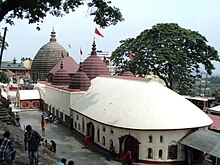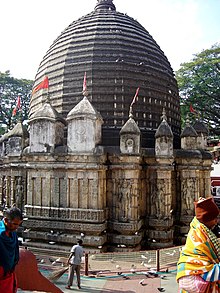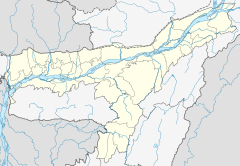
Back معبد كاماخيا ARZ কামাখ্যা মন্দিৰ Assamese कामाख्या मन्दिर AWA कामाख्या मंदिर Bihari কামাখ্যা মন্দির Bengali/Bangla Templo de Kamakhya Spanish कामाख्या मन्दिर Hindi ಕಾಮಾಕ್ಯ ದೇವಾಲಯ Kannada कामाख्या मन्दिर MAI കാമാഖ്യ ക്ഷേത്രം Malayalam
| Kamakhya Temple | |
|---|---|
 Kamakhya Temple | |
| Religion | |
| Affiliation | Hinduism |
| Deity | Kamakhya |
| Festivals | Ambubachi Mela |
| Location | |
| Location | Nilachal Hill, Guwahati |
| State | Assam |
| Country | India |
| Geographic coordinates | 26°09′59″N 91°42′20″E / 26.166426°N 91.705509°E |
| Architecture | |
| Type | Nilachal type |
| Creator | Mlechchha dynasty.[1] Rebuilt by Koch King Nara Narayan and Ahom kings |
| Completed | 8th-17th century[2] |
| Specifications | |
| Temple(s) | 6 |
| Monument(s) | 8 |
| Website | |
| www | |

| Part of a series on |
| Shaktism |
|---|
 |
|
|
The Kamakhya Temple at Nilachal hills in Guwahati, Assam is one of the oldest and most revered centres of Tantric practices,[3] dedicated to the goddess Kamakhya. The temple is the center of the Kulachara Tantra Marga and the site of the Ambubachi Mela, an annual festival that celebrates the menstruation of the goddess.[4] Structurally, the temple is dated to the 8th-9th century with many subsequent rebuildings[5]—and the final hybrid architecture defines a local style called Nilachal.[6] It is also one among the oldest 4 of the 51 pithas in the Shakta tradition.[7][8] An obscure place of worship for much of history it became an important pilgrimage destination, especially for those from Bengal, in the 19th century during colonial rule.[9]
Originally an autochthonous place of worship of a local goddess where the primary worship of the aniconic yoni set in natural stone continues till today,[10] the Kamakya Temple became identified with the state power when the Mleccha dynasty of Kamarupa patronised it first, followed by the Palas, the Koch, and the Ahoms.[11] The Kalika Purana, written during the Pala rule, connected Naraka, the legitimizing progenitor of the Kamarupa kings, with the goddess Kamakhya representing the region and the Kamarupa kingdom.[12]
It has been suggested that historically the worship progressed in three phases—yoni under the Mlechhas, yogini under the Palas and the Mahavidyas under the Kochs.[13] The main temple is surrounded in a complex of individual temples dedicated to the ten Mahavidyas of Saktism, namely, Kali, Tara, Tripura Sundari, Bhuvaneshwari, Bhairavi, Chhinnamasta, Dhumavati, Bagalamukhi, Matangi and Kamalatmika.[14] Among these, Tripurasundari, Matangi and Kamala reside inside the main temple whereas the other seven reside in individual temples.[15] Temples for individual Mahavidyas together as a group, as found in the complex, is rare and uncommon.[16]
In July 2015, the Supreme Court of India transferred the administration of the Temple from the Kamakhya Debutter Board to the Bordeuri Samaj.[17]
- ^ "Along with the inscriptional and literary evidence, the archaeological remains of the Kamakhya temple, which stands on top of the Nilacala, testify that the Mlecchas gave a significant impetus to construct or reconstruct the Kamakhya temple." (Shin 2010:8)
- ^ "it is certain that in the pit at the back of the main shrine of the temple of Kamakhya we can see the remains of at least three different periods of construction, ranging in dates from the eighth to the seventeenth century A.D." (Banerji 1925, p. 101)
- ^ "Seated on top of Nilacala hill on the banks of the Brahmaputra river in the state of Assam, Northeast India, Kamakhya temple is one of the oldest and most revered centres of Tantric practice in South Asia." (Urban 2019:256)
- ^ "Today, Kamakhya remains both a vibrant centre of Tantric practice as the seat of a living lineage of the Kulacara Tantra Marga and a popular pilgrimage destination as the locus of major festivals such as Ambuvacī Mela." (Urban 2019:257)
- ^ Cite error: The named reference
shin10p5fwas invoked but never defined (see the help page). - ^ Cite error: The named reference
harvcolwas invoked but never defined (see the help page). - ^ (Urban 2008, p. 500)
- ^ The four oldest of [the sakta pithas] are Kamarupa in the northeast, Uddiyana in the north (in the Swat Valley of modern Pakistan), Purnagiri in the south (precise location unknown) and Jalandhara (near Kangra in Himachal Pradesh)" (Urban 2019:261)
- ^ " As Ramos persuasively argues in her study of the sakta pithas, the once obscure and remote region of Assam became increasingly important to many Indians (particularly Bengalis) during the nineteenth century amidst the politics of British colonial rule." (Urban 2019:265)
- ^ (Shin 2010:3)
- ^ "Long after the collapse of the Pala dynasty, Kamakhya continued to be closely tied to kingship and territory. The temple was rediscovered in the sixteenth century by the Koch king Visva Singha (1515–40) and then rebuilt in its present form by his son Naranarayana (1540–86). Later, the most powerful of the Ahom kings, such as Rudra Singha (1697–1714) and Siva Singha (1714 _ –44), continued to patronise Sakta Tantra as the 'cult of strength'" (Urban 2019:265)
- ^ "The story of Naraka is far more elaborate in KP in which his relationship with the goddess Kamakhya is heavily emphasized... Here the goddess is not merely a local goddess but a representative deity of the region and kingdom of Kamarupa..." (Shin 2010:10)
- ^ Shin (2010, p. 3)
- ^ "The group of Mahavidyas, ..., is the most comprehensive Sakta Tantric pantheon." (Shin 2010:4)
- ^ (Shin 2010, p. 4)
- ^ Shin (2010, p. 4)
- ^ Kashyap, Samudra Gupta (14 July 2015), As SC directs the return of old order at Kamakhya, looking back, and ahead
© MMXXIII Rich X Search. We shall prevail. All rights reserved. Rich X Search

